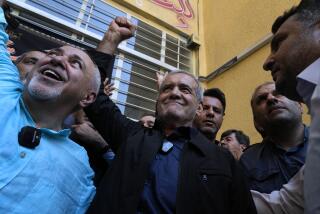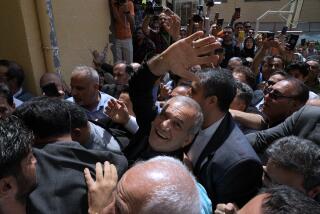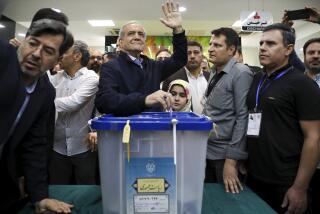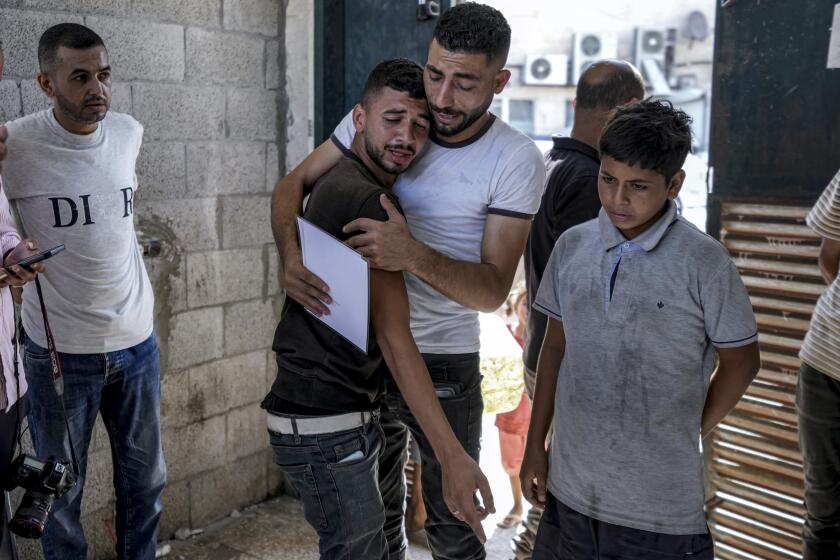Striving to be Both a Theocracy and a Vibrant Democracy
WASHINGTON — A generation after its Islamic revolution, Iran is witnessing a transformation that could be as profound as the upheaval that ended 2,500 years of monarchy. The world’s only modern theocracy is becoming a democracy.
Like many countries in the throes of transition, Iran still has a long way to go. But the once unthinkable is now possible.
Imagine this: The country that the West once feared most because of its fiery Muslim militancy could evolve into a model of what the West would actually like to have happen elsewhere in the Islamic bloc, a group of 50-plus countries with the world’s last functioning monarchies and the largest number of authoritarian regimes.
But the stunning sweep by reformers in Iran’s elections on Feb. 18 shouldn’t have come as a surprise.
First, Iran has followed the natural rhythm of all revolutions. Each passes through stages like the course of a disease: from early delirium to a convalescence, often set back by relapses and, finally, recovery. Iran is now in that final stage of returning to political health and normality--or at least trying to.
It’s visible today not only at the ballot box. Since President Mohammad Khatami’s election in 1997, which marked the first turning point, Iran’s feisty new alternative press has run scoops on intelligence-ministry misadventures; exposes on state corruption; editorials against practices such as stoning for adultery; critiques of the loftiest clerics, including former President Hashemi Rafsanjani; and even interviews with U.S. officials.
Despite harassment, trials on charges of un-Islamic activities and some forced newspaper closures, the press has persevered. Iran’s bold movers have dared to tackle such issues as the regime’s failure to address poverty, women’s rights, racial bias and child exploitation. One movie with three endings challenged the idea of a single truth--or a “single path,” the term invoked by conservative clerics in justifying their singular vision of an Islamic state.
Second, and with special irony, Iran’s revolution created the very conditions that eventually unseated the clique of conservative clerics who hijacked the revolution after the shah departed and crafted an authoritarian theocracy.
The Islamic Republic bred a huge generation of young people, now coming of age, and gave them the vote at age 15. It educated females, for which it won U.N. commendation for closing the gender literacy gap. It brought traditional religious families into the political system, once considered anathema because politics were scorned or distrusted by most Iranians during the monarchy.
A new generation is now reclaiming the revolution and putting it back on its original course.
In the past two years, thousands of youths risked their lives to protest the banning of newspapers, arrests of their peers and persecution of reformers. Last summer, they took to the streets of Tehran and a dozen other cities in the most extensive unrest since the revolution. The scope of change is reflected in that many of those youths belong to an offshoot of the student organization that held 52 U.S. hostages from 1979 to 1981. Two decades ago, they blamed the United States for blocking the course of empowerment because of its support for the shah. Today they blame their own government.
Women, too, have campaigned against theocratic rules, with particular effect on employment and divorce. They packed a courtroom to protest the death of an 8-year-old girl--weighing only 35 pounds and with a battered head, two broken arms and burn marks all over her body--at the hands of her father, who had a long record of child abuse. Islamic law requires that children of divorce must be given to the father, a boy after age 2, a girl after age 7. The women’s campaign led parliament to change child-custody laws, giving precedence to human rights over Islamic law.
Third, Iran’s revolution was always part of a global trend that defined the modern era: the quest for individual rights such as free choice, free speech and the sharing of power. Intellectuals in the Islamic world, from Egypt to India, have been struggling for a century to reconcile Islam with modernity, or blend political freedom with religious thought, to create an Islamic democracy. But the effort was limited to elites until Iran’s 1979 revolution converted it into a mass movement.
During the revolution’s first decade, conservative clerics managed to preserve their purist vision of an Islamic state courtesy of crises, particularly the eight-year war with Iraq, the U.S. hostage standoff and the death edict against “Satanic Verses” author Salman Rushdie. Each was manipulated to invoke Persian nationalism and divert attention from the real issues that provoked the revolution.
But increasingly during the second decade, Iranian thinkers and reformers have pushed for the Islamic Republic of Iran, the country’s full title, to be more of a republic and less rigidly Islamic. Again with special irony, clerics are now taking the lead in challenging their peers.
The emergence of a wide political spectrum is reflected in the groups that ran for parliament. Within the reformist camp, there are 18 different factions. Conservatives have 15 of their own. There are other parties, such as the Freedom Movement, that belong to neither.
For all the euphoria over the reformers’ overwhelming victory in parliamentary elections, however, there’s still no guarantee they will succeed. Indeed, Iran’s nascent democrats face greater pressures today than during the years they faced down the conservatives.
The first problem is runaway expectations--from the very people who elected them. President Khatami has had one of the longest political honeymoons of any head of state because, until now, the vast majority of the population unhappy with the system blamed conservatives for their woes. Now Khatami and the reformers are the majority in power. They will be expected to deliver.
The second challenge is the state itself. The Islamic republic has a unique and unwieldy political system with a parallel power structure: Every political body is mirrored by a religious body, controlled by clerics who invoke powers bestowed by God, that has the last word.
Thus, the president is mirrored by the supreme leader, who is also commander-in-chief and in charge of intelligence and, to some degree, foreign policy. The parliament is mirrored by the Council of Guardians, which can veto both candidates for parliament and laws parliament passes. And the civil and criminal courts are mirrored by revolutionary courts run by the clergy, who can haul anyone up on almost whimsically defined un-Islamic activities.
In other words, concrete reforms can be blocked at every turn--unless the balance of power is realigned. That’s where conservatives are virtually certain to draw the line.
Finally, the regime faces its biggest problem on the issue that eventually undid the Russian revolution: the economy. In the world’s third-largest oil producer, the average income today is less than half what it was before the revolution. Many people hold two and sometimes three jobs to make ends meet, and they’re the lucky ones. Unemployment is officially between 15% and 20% but may be twice as high, according to diplomats.
The economic morass is complicated by disagreement among the factions under the reform umbrella about the best policy to reverse the cycle. In other words, the outside world should have no illusion about what lies ahead. Iran’s reformers still face enormous obstacles.
The West should also have no illusions about the reformers’ intent. The main message from the election is that the vast majority of Iranians want the benefits of modern democracy. But that doesn’t necessarily mean a secular state.
The chador is a symbol. While many women are ready to shed the restrictive dress, large numbers of female activists would still opt for some form of modest Islamic attire. The same is true in politics.
The reformers’ mission from the beginning has been to reform Islam and make it compatible with democracy. And for the foreseeable future, Iranian politics will continue to be defined by the values of the faith. Just as at the time of the revolution, Iranians are intent on creating their own model--not copying anyone else.
More to Read
Sign up for Essential California
The most important California stories and recommendations in your inbox every morning.
You may occasionally receive promotional content from the Los Angeles Times.









